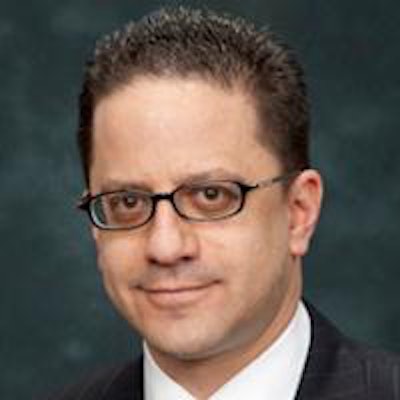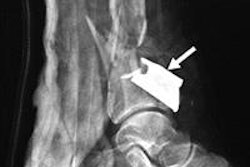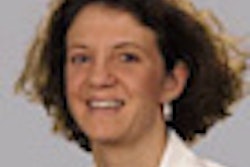
Monday, April 15 -- Patriots' Day in Boston -- started much like any other day for radiologist Dr. Robert Ward of Tufts Medical Center. But it turned out to be anything but normal after two bombs exploded at the end of the Boston Marathon, sending dozens of injured people to Tufts with battlefield-like injuries.
Ward is chief of musculoskeletal imaging and has been on the job at Tufts for more than five years. He'd finished his administrative duties for the day and was reading routine imaging studies when he received a text from his wife shortly before 3 p.m. A friend, who is a gastroenterology fellow at Boston University and was running in the marathon, told Mrs. Ward there had been explosions heard near the race's finish line.
 Dr. Robert Ward from Tufts Medical Center.
Dr. Robert Ward from Tufts Medical Center.
"My first inclination was that there was some sort of minor mischief; maybe someone dropped some firecrackers or something like that into a garbage can," Ward said. "Then a colleague poked his head into the reading room and said there were explosions, limbs were lost, and there were several people dead. At that point, it became an entirely different matter."
Marathon bombings
Soon thereafter, Ward, the city, the nation, and the rest of world would come to learn that two homemade bombs had been detonated within seconds of each other about 200 yards apart along the path to the finish line. In the end, three people died and more than 260 bystanders and runners were injured, some hurt so severely that they lost limbs.
On a normal Boston Marathon day, most patients at Tufts present with dehydration, or a couple of days after the race, people arrive with extremity abnormalities. There are 22 radiologists and 22 residents at the medical center, with 16 or 17 staff members onsite at any given time.
Word spread quickly that bombing victims were on their way to the level I trauma center.
"I elected to go down to the ER," Ward recalled. "Patients were starting to come in, probably five times the normal number of people who are in the emergency department [at that time of day]. That place was really in a chaotic manner."
He estimated there were 13 marathon patients in the emergency room, most of whom were young and probably runners. Most injuries were isolated to the lower extremities; a fair number of patients had skin ripped away from their bodies. What's more, the limbs of many patients were embedded with the "strangest foreign bodies [and] shrapnel like we have never seen before."
Some patients had BBs lodged in their extremities, as well as what Ward described as twisted, metallic items that must have been 2 to 4 inches in size. "Generally, those [objects] don't make it deep into tissue unless there is a substantial explosion, which was obviously the case," he said.
Onsite care
For the marathon, medical personnel and physicians often take the day off and donate their time to treat race-related injuries and other ailments at a makeshift facility near the finish line. On this day, having that kind of medical expertise so close to the bombings "made for an extraordinary rapid response," Ward said. "It was almost like battlefield medicine in a sense."
Under normal circumstances, Tufts' protocol is to acquire two right-angle x-rays of leg and ankle injuries to determine their extent and location.
"Because of the emergent nature of the injuries, we would get one x-ray and [patients] would go straight to the operating room," Ward explained. "It is purely a time issue. With some of the bizarre shrapnel fragments that we were seeing, it was hard to believe they were actually inside people."
Patients with injuries above the waist received a CT scan of the chest, abdomen, and pelvis.
Ward stayed in the emergency department for about 30 minutes, collaborating with a fellow radiologist in the reading room. He later joined the rest of his colleagues, all of whom stayed late into the evening to process all the image interpretations that needed to be done.
Radiology was one of several departments at Tufts that rallied additional personnel to respond to the emergency conditions. The orthopedic department, for example, called in its entire staff to assist in the operating room.
Ward described the coordination between the radiologists and the surgeons as "seamless," adding that communication between caregivers functioned the same as during any other day at the medical center.
"We have a very well-patterned response, and we were doing our job the same way we do every day, except with a little bit more intensity, given the experience," he added. "When consultations were necessary, the lines of communication were open."
Lessons learned
In the wake of the Boston Marathon bombings, Tufts will likely review its emergency response to the event and modify its disaster protocol, if needed, just as it regularly assesses its preparedness through periodic drills.
Within the past 18 months, Tufts was upgraded from a level II to a level I trauma center, which included the implementation of protocols for trauma and potential disaster scenarios.
"In the global sense, we are in the business of helping people, and every day you wake up and have to be aware that you never know what's going to come your way," Ward reflected. "You have to be ready, and vigilance is key in every aspect, whether it's homeland security or taking care of patients who are victims of dramatic, unforeseen events. It brings an urgency to the importance of quality care and making sure that everyone in the department is ready to go at any moment."
A few days after the tragedy, Ward and a colleague dined at a Boston restaurant while still wearing scrubs, as they had come straight from work. At the end of their dinner, the server insisted that they allow the restaurant to pay for their meal in gratitude for their service. The server told them his friend was treated in the neuro intensive care unit at Tufts during that week and had recently been discharged.
"We were both speechless," Ward recalled. "That's just us doing our jobs. The real tragedy is the people who wanted to go see a race, were running in the marathon, and were victims of this tragic incident. We are in the business of helping people. Whatever we can do to help is why we went into this endeavor to begin with."




















